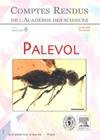Siega Verde and the open-air rock art of the northern Iberian Peninsula (Spain)
IF 1.3
4区 地球科学
Q3 PALEONTOLOGY
引用次数: 0
Abstract
Siega Verde was the third open-air rock art site to be discovered in the Iberian Peninsula, even before Côa and the controversy that followed that discovery. Its practicable size and the study carried out without any publicity allowed the analysis of a new reality that would change the interpretation of Palaeolithic art. From the start of the research, stylistic criteria were used to date the art in the absence of archaeological excavations. Although this has often been criticized, it meant that Siega Verde and Côa could be dated from Leroi-Gourhan’s Style II onwards. Excavations at Fariseu, a site belonging to Côa in Portugal, have proved that hypothesis archaeologically, as well as supporting the applicability of Leroi-Gourhan’s styles. Siega Verde is a good representative of Palaeolithic art in the open, on rocks by a river-bank or on prominent hills, but it is not the only form that can be catalogued as open-air rock art, because there are intermediate forms. These are found in cave entrances and in rock-shelters all over the Iberian Peninsula, especially in areas where little evidence of Palaeolithic art used to be known, such as on the southern Mediterranean coast and in Andalusia. This site possesses an exterior Upper Palaeolithic art ensemble, similar to the art found inside caves and of the same age, but in a different location. Formal relationships are usual inside and outside the caves and in both cases they represent a communicative code that did not need the dark and mystery to be expressed.Siega Verde和伊比利亚半岛北部的露天岩石艺术(西班牙)
Siega Verde是在伊比利亚半岛发现的第三个露天岩石艺术遗址,甚至在Côa和随后的争议之前。它的实际规模和在没有任何宣传的情况下进行的研究允许分析一个新的现实,这将改变对旧石器时代艺术的解释。从研究开始,在没有考古发掘的情况下,风格标准被用来确定艺术的年代。虽然这经常受到批评,但这意味着Siega Verde和Côa可以追溯到Leroi-Gourhan的风格II之后。在Fariseu(葡萄牙Côa的一个遗址)进行的挖掘从考古学上证明了这一假设,也支持了Leroi-Gourhan风格的适用性。Siega Verde是旧石器时代露天艺术的一个很好的代表,在河边或突出的山上的岩石上,但它并不是唯一可以被归类为露天岩石艺术的形式,因为还有中间形式。在伊比利亚半岛各地的洞穴入口和岩石掩体中都发现了这些壁画,尤其是在地中海南部海岸和安达卢西亚等几乎没有旧石器时代艺术证据的地区。该遗址拥有旧石器时代晚期的外部艺术组合,类似于在洞穴中发现的艺术,但在不同的位置。正式的关系通常是在洞穴内外,在这两种情况下,它们都代表了一种不需要黑暗和神秘来表达的交流代码。
本文章由计算机程序翻译,如有差异,请以英文原文为准。
求助全文
约1分钟内获得全文
求助全文
来源期刊

Comptes Rendus Palevol
地学-古生物学
CiteScore
2.10
自引率
0.00%
发文量
39
审稿时长
17.6 weeks
期刊介绍:
Comptes Rendus Palevol is a fully electronic and peer-reviewed journal, with a continuous publication stream, devoted to palaeontology, prehistory and evolutionary sciences. It publishes original research results, in French or English, in the following domains: systematic and human palaeontology, prehistory, evolutionary biology and macroevolution, and history of sciences. Thematic issues may also be published under the responsibility of a guest editor. All articles published in Comptes Rendus Palevol are compliant with the different nomenclatural codes. A copyright assignment will be signed by the authors before publication.
 求助内容:
求助内容: 应助结果提醒方式:
应助结果提醒方式:


